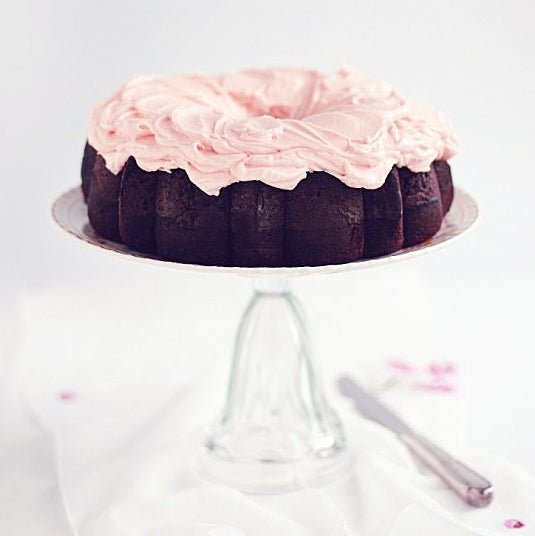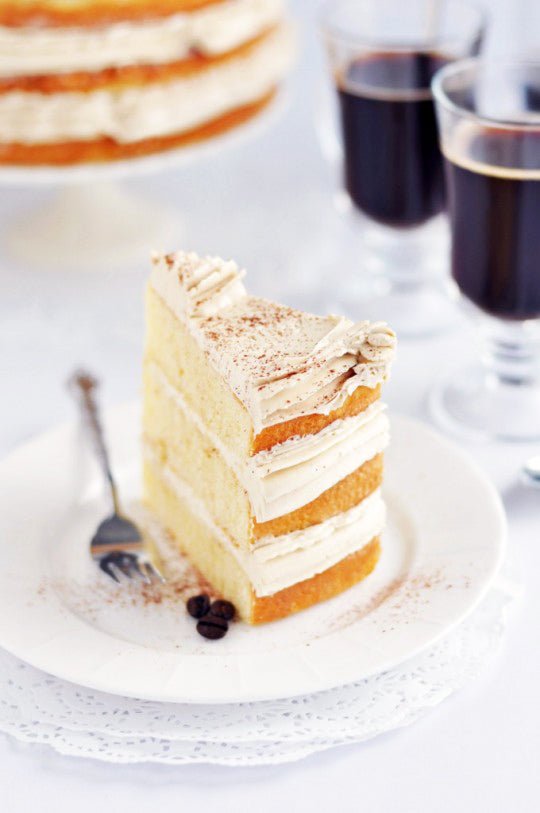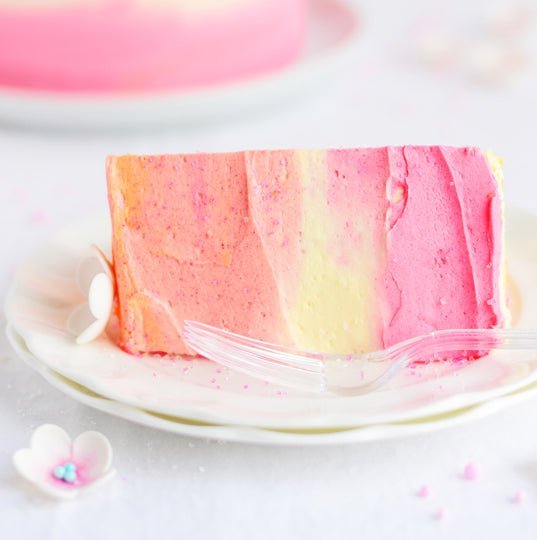
There's something about the word "chiffon" that simply makes me happy. And hungry. Pair it with the word cake, and you know I'm going to be intrigued. I've been wanting to share a chiffon cake with you for some time now, but truly, there are so many flavour variations out there that I felt it would be best to wait until I made one that really excited me and that I found unique and nothing short of delightful. What makes a chiffon cake a chiffon cake? Well, it's a light and springy cake that gets its height from a generous number of egg whites that are beaten separately from the egg yolks into a stiff peak meringue and folded into the blended batter base, which typically includes oil (never butter), flour, baking powder, and sugar. It bakes up lofty and full, and the high oil and egg content yields a really moist cake that seems to stay that way for days. With the absence of butter, therefore less saturated fat, you could almost say that it's a healthier cake option, and, this is what I uttered to myself repeatedly while I ate 2, or was it 3, slices today. And, wait, I also used sunflower oil, so I almost can't afford to not eat it, it's that healthy.

According to What's Cooking America, the first chiffon cake was introduced in 1927, by its inventor, Harry Baker, a Los Angeles insurance agent who kept his recipe guarded for two decades, baking and selling it to Hollywood stars exclusively. It is explained that Mr. Baker eventually (1947) sold his recipe to General Mills, who stated that he sold his recipe" so Betty Crocker could give the secret to the women of the America." This cake was said to be a huge hit after being printed in Better Homes and Gardens in 1948, and by the 1950s chiffon cakes were all the rage. So now that I've inflicted my love for cake history upon you, let's talk about this particularly delicious chiffon cake!

I've been wanting to incorporate rosewater (or rose water) into a recipe (or a few) lately, and although it's known to work well with such flavours as vanilla, white chocolate, raspberry, and many others, I was so excited to pair it with chocolate. I suspected it would taste great, since lavender does and my instincts told me it would, but I was particularly pleased to discover this officially, since all I can think about these days is chocolate. And cake. And pink frosting. I went with a dark chocolate chiffon cake because I love the contrast of the delicate, pink, fluffy rose water frosting against the deep, dark chocolate cake--both in taste and aesthetic. In this case, though, since the cake only appears to be heavy and dark, it's actually super light in texture (in true chiffon style), which makes the overall experience even more pleasing and suited for spring indulgences and summer days to come.
For this frosting, I added a small amount of rosewater to one of my favourite sugary-type frosting recipes, as an accent, resulting in a sweet, rich-but-light buttercream with just a hint of rose ringing through. With a certain magical tea party on my mind (you can learn more about that wonderfully curious event below), I've been recently dreaming of this type of sweet and fragrant confection, and this one hit the spot. If you're not familiar with rosewater, it is literally just that: a steam distillate made from rose petals. Although there are many wonderful uses for rosewater (I use it in toner form on my face each day), as an ingredient it's most often found in Middle Eastern, Greek, and Indian cuisine. I find it adds a really delicate and unique touch to the frosting in this case.
I opted to add it into more of a confectioners' frosting, over my beloved meringue buttercream, or the like, because I felt, after experimenting a bit, that for my personal taste it paired best with the sweetness of the sugary frosting. A rosewater glaze was also an option, and I imagine that would have also been incredible. I was envisioning swirls of fluffy rosewater frosting though on a bundt shape cake this time, so maybe next time, when I try it ungreased in a chiffon (or angel food cake) pan, I'll try the glaze.

One of the notable differences between making a bundt cake and a chiffon cake, aside from bundt cakes including butter, is that chiffon cakes typically require an ungreased cake pan. From what I've read, this is so the light cake can cling to the edges of the pan, allowing it to rise to, and stay, a lovely and lofty height. The recipe I used for this cake, from contributing pastry chef Mary Bergin from the fabulous book Baking With Julia, did instruct greasing and flouring the pan, so I did. Her incredible recipe from the book is a decadent creme brulee with Chambord filled and glazed version using the bundt shape as an important part of the dessert's structure and appeal, so I imagine that is why she greased the pan; in my experience, if you don't butter and flour a bundt pan properly, you'll likely never get the baked cake out in one piece.
So . . . creme brulee and raspberry liquer inside the cavity and drizzled all over a chocolate bundt cake, you ask? Oh yes, and I cannot wait to make that entire recipe someday soon, when I'm armed with a flurry of friends who will help me devour it. The source is linked below, if you can't wait another day to make that version, and if you do, please come back and tell me how it was! As for this version, I love its sweet simplicity and unique flavour combination. Next time, I will definitely give it a try that way in an ungreased chiffon cake pan with removable bottom, just to get a better idea of the difference in height.

If you make it, don't be afraid to really slather on that frosting; it was a highlight (although, I recommend not going overboard with the rosewater; it can overtake the flavour if you're not careful)! I loved the combination of flavours, and I really enjoyed the springy texture and deep "chocolate-ness" of the cake. I didn't opt for it this time, but you can top the cake with some edible glitter for a bit of extra sparkle.
Just a note that if you'd rather make an actual bundt cake with this frosting, which would also be a great combination, you can bake my Chocolate Espresso Bundt Cake and top it with the Fluffy Rosewater Frosting.
Dark Chocolate Chiffon Cake with Fluffy Rosewater Frosting
Deep, dark, moist chocolate chiffon cake topped with fluffy and sweet frosting with a hint of Rose.
For the Cake:
- 1-1/2 cups 300g sugar
- 1 cup 130 g all-purpose flour
- 3/4 cup 90g dark unsweetened cocoa powder
- 2 teaspoons 10 g baking powder
- 1 teaspoon 5 g baking soda
- 1/4 teaspoon 1.5g salt
- 4 eggs (separated, and room temperature)
- 1/2 cup 120 ml vegetable oil (I used Sunflower oil)
- 1/2 cup 120 ml water, warm
- 1 teaspoon 5 ml pure vanilla extract
- 2 egg whites (room temperature)
For the Frosting:
- 1/2 cup 1 stick(114g) unsalted butter, room temperature
- 2 cups 250 g icing sugar (powdered, confectioners'), sifted
- 1 teaspoon 5 ml pure vanilla extract
- 1/4 cup 59 ml whipping cream (heavy cream, 35% fat)
- 1/8 teaspoon rosewater (or more to taste (but use sparingly))
- pinch of salt
- Few drops pink food colour (optional - try a small amount of Sweetapolita Bright Pink for a bold beautiful colour)
For the Cake:
- Preheat oven to 350° F. Butter and flour (I use a mix of flour & cocoa powder for this process when baking chocolate cake) the entire inside surface of a 10-12 cup Bundt pan. You can also use an angel food pan. (Typically, you wouldn't grease the pan for a chiffon cake, but this recipe comes from the book Baking with Julia, and greasing the pan is directed.)
- Sift 1 cup (200 g) of the sugar, flour, cocoa powder, baking powder, baking soda, and salt in a medium bowl.
- In a large mixing bowl, whisk egg yolks, oil, water, and vanilla until blended. Gradually whisk in all of the dry ingredients until combined and smooth. Set aside.
- In a stand mixer fitted with the whisk attachment and a mixer bowl wiped clean with lemon juice, whip the 6 egg whites on medium speed until foamy. Gradually add the remaining 1/2 cup (100 g) of the sugar to the foamy egg whites, and continue to whip on medium speed until the meringue reaches stiff peaks, and is glossy and thick.
- Gently fold in 1/3 of the meringue into the chocolate mixture with a silicone spatula, then gently fold in the remaining meringue until just combined. Pour batter into prepared pan, and bake until top bounces back when gently touched, about 35 minutes, and cake begins to shrink from sides of pan, and skewer comes clean when inserted. Be sure to not over-bake.
- Let cake cool in pan on cooling rack for 25 minutes before gently inverting onto wire rack.
For the Buttercream:
- In mixer fitted with the paddle attachment, combine icing sugar and butter on low, for about 2 minutes. Add vanilla, and mix on low speed for about 2 minutes.
- Add whipping cream and salt, and mix on medium-high for 2 minutes. Add rosewater and pink gel colour, and whip until blended.
Assembly of the Dark Chocolate Chiffon Cake with Fluffy Rosewater Frosting
- Gently place the cooled chiffon cake on a pedestal or plate.
- Smother the top of the cake with Fluffy Rosewater Frosting using a small offset palette knife.
- Store in a cake-keeper at room temperature for up to 3 days.
*Rosewater is very fragrant, and very intense in flavour, so you will want to use sparingly, to taste.
**The chiffon cake can be baked in advance, wrapped tightly in plastic wrap, and frozen for up to 1 month. Thaw at room temperature.
*Cake recipe adapted from Mary Bergin's recipe in the book Baking With Julia, by Dorie Greenspan. I found the online recipe here. Now, onto this glorious Mad Tea Party! I have a special friend, who you may already be familiar with, artist Vanessa Valencia; she's the magical, quirky, and infinite talent behind A Fanciful Twist art, blog, and so much more. Okay, so I don't use that adjective very often, "magical," but to describe Vanessa, well, there's no other way to say it, and once you step into her world, you'll likely agree. It's not just Vanessa who is magical, but everything she touches, including her living and work spaces. You may remember my chatting about her in my previous post, Artist Palette & Paintbrush Cookies (with a special "Twist"), well, she's the special twist. Can you tell I adore her madly? This year she's hosting her annual virtual Mad Tea Party, and oh me, oh my, I'm the honorary guest! On Saturday, June 25th, 2011 I'll be sharing my Mad Tea Party post here on my blog, filled with curious tea party confections, recipes, and more. If that's not fun enough, there will be oodles of other virtual attendees sharing their mad blog posts, all linked and hosted through her blog on A Fanciful Twist blog.



